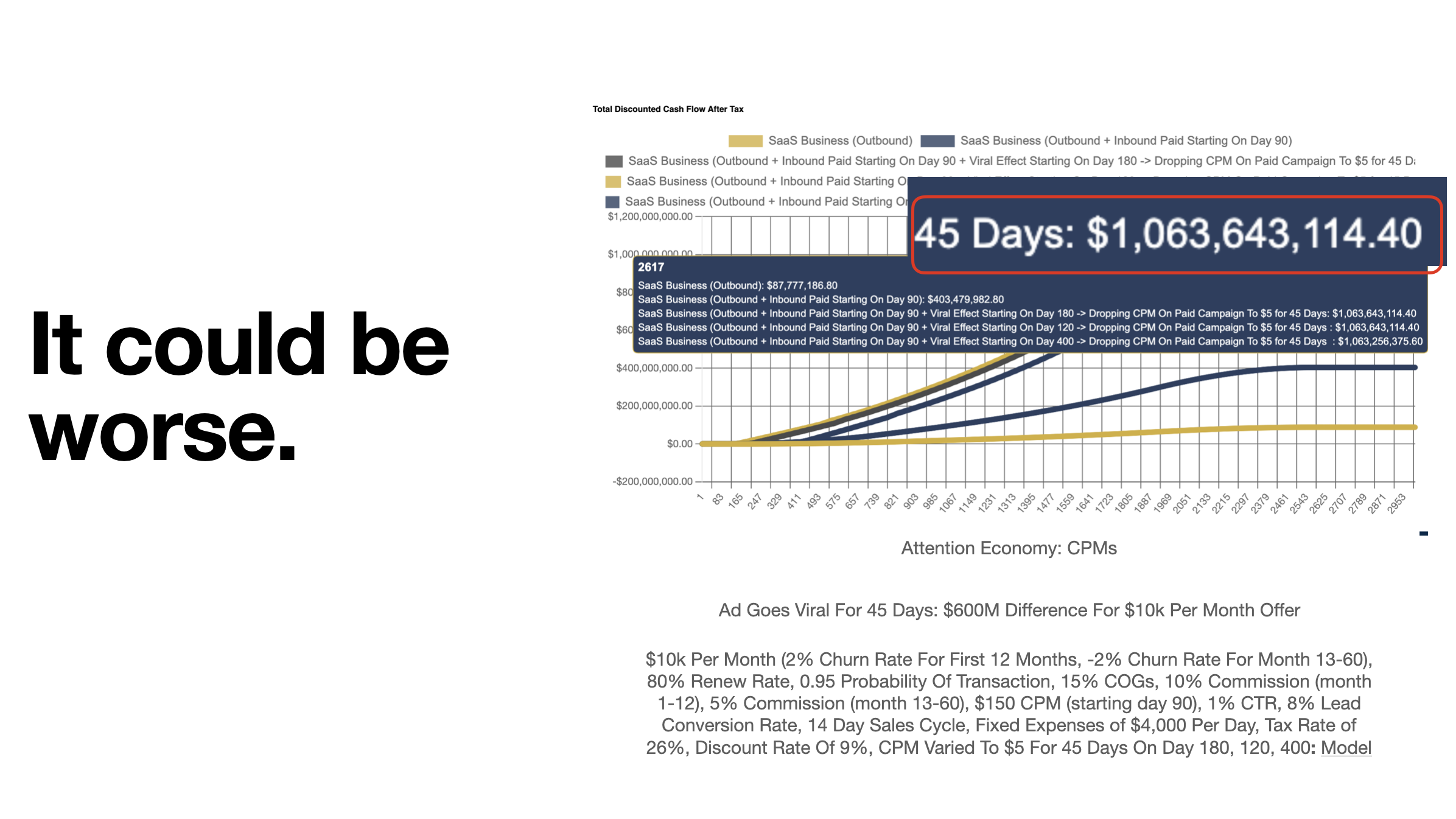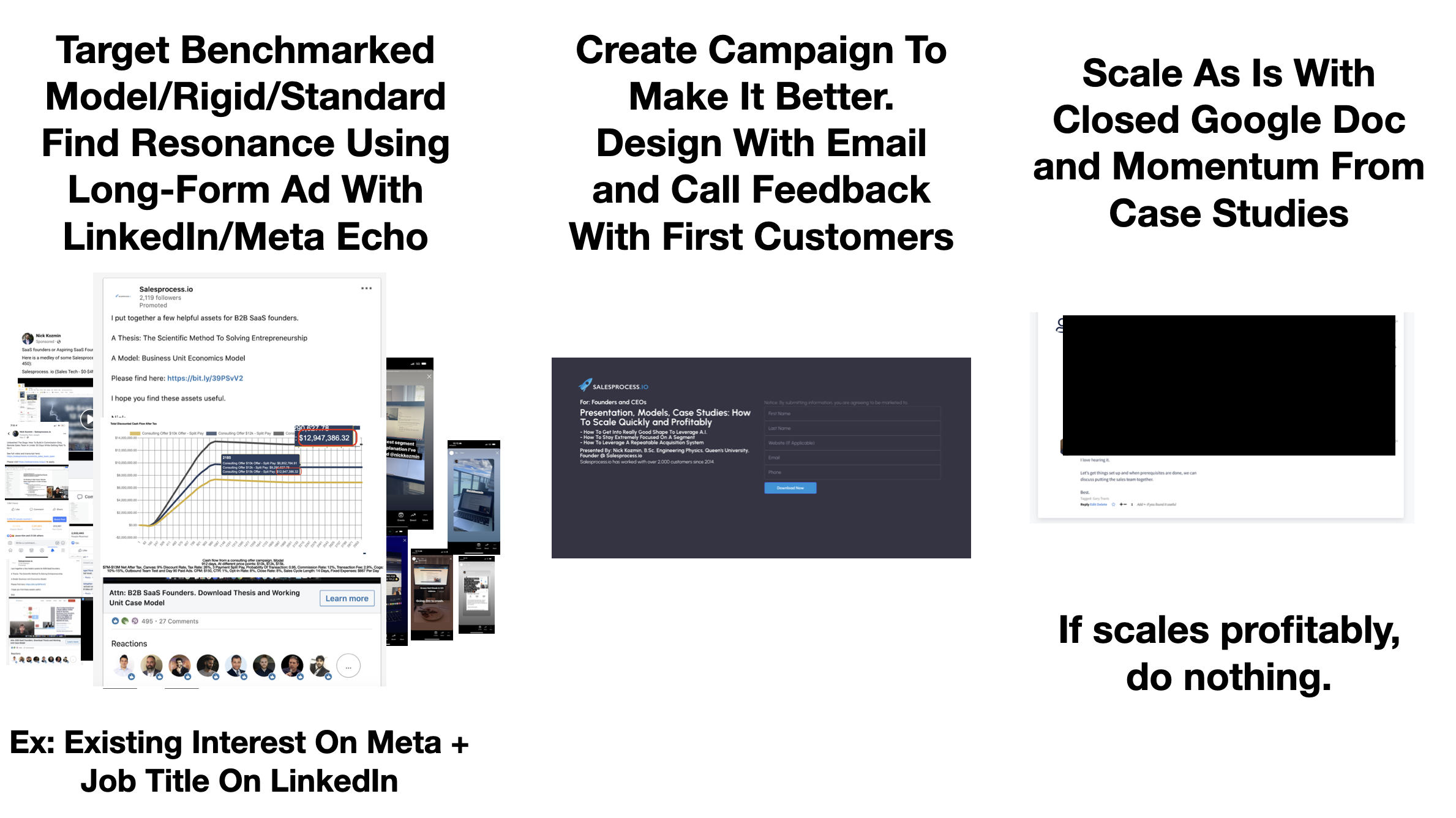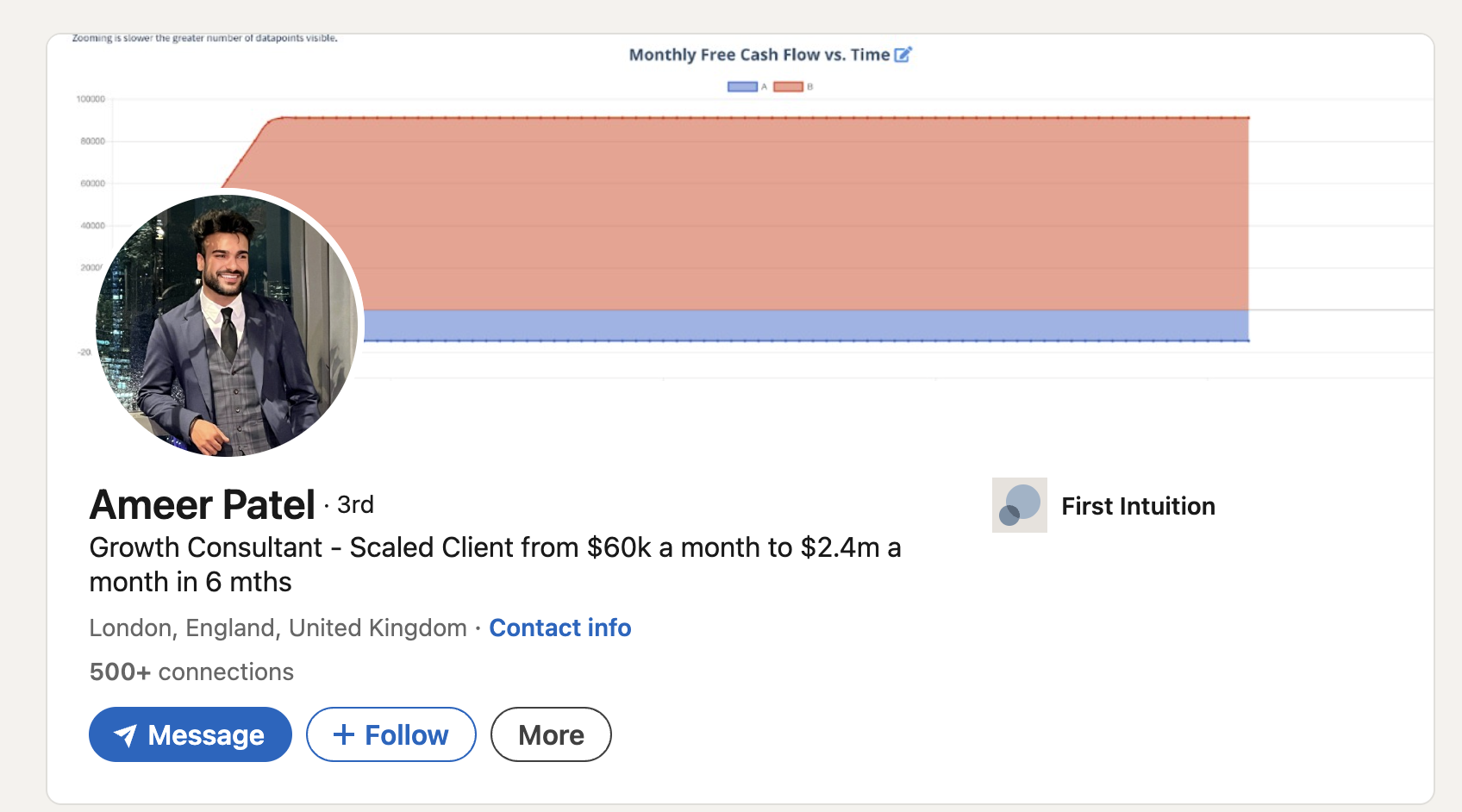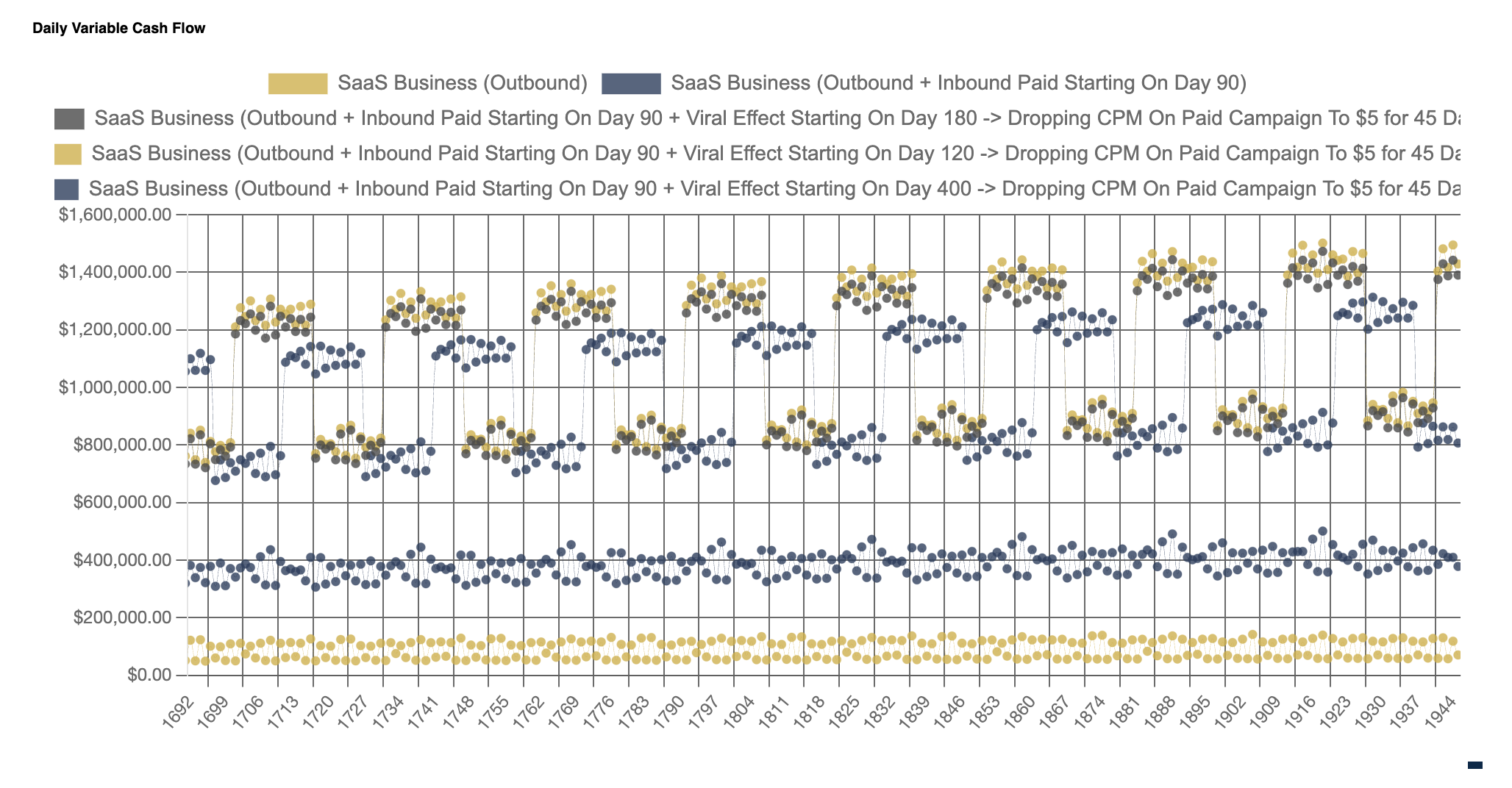Find A Customer and Your Edge By Simulating
F--- A Model Fashioned: CPM Arbitrage: $15k USD
CPM Arbitrage:
Using existing platforms and combining them in unique ways to get CPM deltas, then selling the CPM delta to others using paid advertising. You can create value by minding the gaps between platforms.
Niche Development Workbook (Customers Only) Use this to map out the case studies and get visibility of the required data to create the campaign and to focus on a direction. If you don't yet have a direction, you can use this to get ideas to find a direction or customer. Pick the customer who paid you the most.
Designing The Mechanism: Algo Design: Designing Your Cosmetic
You are auditing the tools you used to get to the initial point and strategy that you used to get the initial CPM delta over other solutions in the market.
The ratios and strategy used are what are important. For example, when I was putting together the remote sales team mechanism (sold $13.5M with a single ad), I discussed the ideal team size, the training schedule, the recruiting schedule, and the specific messaging used to recruit and train. Creating templates for others to use the strategy. In other words, the strategy was a cheaper way to generate traffic using outbound methods with proper training than ads, allowing anyone who learned of the strategy to get cheap or free eyeballs for their offer. Selling eyeball benefit for eyeball cost (using paid ads) allowed CPM arbitrage. You can create CPM arbitrage in many ways. For example, for my first case study customer, I helped position their recruiting solution (a way to recruit shift-based workers for malls) as marketing benefit. Doing this made it easier to show ROI since the benefit can be quantified. Yes, there was of course efficiency gains for recruiting, but there was also a marketing component if the right lens was used. Using the lens filter: CPM, we can quantify benefit since the price of search traffic is sometimes public. Using benchmark conversion metrics found with industry insights, or even A.I., we can approximate the benefit, design a solution, and sell it to customers using a linear pitch. To communicate the benefit using this lens, we use a model and create an algo...
How To Design The Algo:...
Create A Model That Outlines CPM Delta For Theoretical Or A Customer’s Offer Using Benchmark Conversion Metrics Using Synthetic Data
By decreasing the CPM for an amount of time at a particular point in time, you can show/approximate a benefit. An example is decreasing the CPM by 95% on a campaign selling a $10k per-month ticket, with $150CPM for a period of 45 days on day 120, 140, or 180. This is a way to project your arbitrage strategy and value it for a customer’s business.
Use Model Spreadsheet to get idea of your benefit first.
Use SPIO Sims solution to show benefit over a longer time frame and to get an actual benefit. Picture below. Sign Up For Spio Fashion Model: $15k USD to get access. You use this in your ads to do wild stuff.

Once we have the benefit, we can start designing the pitch using the three-steps.
Are you dancing on YouTube?
Are you doing A.I.?
Are you doing events because you can't scale your ads/don't know the ratios to scale, and all of a sudden you are a content creator?
Do you have an organic outbound strategy that you are selling done-for-you and want to scale it up with a program and break the internet?
Did you raise money for a startup and want to sell big-ticket deals, but don't have a unique data-set to train your a.i. and want to acquire one profitably?
Do you want to do nothing and have money come to you?
Did an a.i. suggest to you once to run only meta ads, then put people into a meta group? Or make a group on Go, and push youtube traffic to that group, and you can't figure out why only one person is making profit with that model? Did you not think to splice in an independent channel to sustain variance, or maybe you thought to splice in another channel, but can't dial in the ratio to scale because you are dancing on YouTube and resetting initial conditions with each video? Bringing people from one area of meta to another...? Bringing people from one area of google to another area of google?...and maybe you catch yourself becoming a payment processor? Is the only way to capture profit, really, to do innovation on payments between the stops from one area to another on the same platform? Is it that hard to mix in an X? Or mix in a LinkedIn and balance? Are banking payment rails really that bad or could it be something else? Why not go full bonnie blizzards? You are already on YouTube... Why holding back?
Greg O'Gallagher, founder of Kinobody, made $4M in profit after just one year by rewriting an ad with me. The most profitable ad angle was written for him in 2017: "If you had 3 months to get into shape for a Hollywood movie, WHAT WOULD YOU DO?"
Brandon, from Seamless.ai, formally sales at Google, ramped up to $100M in revenue and $400M valuation after I ran his ads. "The world's best sales leads." If you are from Google, book a call.
Alex Becker, ramped up Hyros after learning about the outbound prospecting side of things and how it related to the copywriting and pricing: Adding variance to his advertising strategy and high-ticket approach. He sold the company and is managing his money by being a crypto influencer.
Raj, from thinkster math, double his revenue after working me with to update his copywriting. He doubled revenue after launching the ad.
Erol Toker, a founder at Greylock, was one of the first people to use the somewhat-formalized copywriting algo back in 2018. Him and I went back and forth to ring out some of the details so he could give it to his team. Now he is a tuning: The Solo Capitalist
Henry Bee, from Copilot, who I worked with to design his product and marketing is now running a hedge fund after ramping up past $5m ARR with $80M valuation. The product was based on a arbitrage strategy using LinkedIn outbound prospecting and a specific message I wrote to generate leads for advisors.
Kevin, a founder from Advisorstream, who I helped by ramping the machine up to the first $1M ARR, did a version of CPM arbitrage with financial advisor newsletters. He scaled up to millions in ARR and got acquired by Broadridge in 2021.
Northsypre, a cloud-based intelligence platform for real estate professionals raised $7.5M and then $25M after working with me.
Velcre, a real estate appraisal software raised $12. 7M after working with me.
Sisu.co, a real estate platform raised $128.7M after working with me.
Wise.com, a payment system raised $319M share sale at $5B valuation after working with me.
Chatter research was acquired by Stingray after working with me.
Truelytics was acquired by Envestnet after working with me.
Foxpass, a y-combinator-backed-company was acquired by Splashtop after working with me.
Iman Gadzhi from IAG Media & GrowYourAgency used a version of the copywriting framework to create his content, then he made $8M trading, then became a YouTube star, and now is managing his money using insights from his content platform.
Why does writing copy in this way help with managing money? This is a bit out there, but... by enforcing a somewhat linear relationship between components in a business (what copywriting aims to do): niche, transformation, price, mechanism, access channel, or using some other co-ordinate system, you eventually end up doing innovation at photon level. Deeper techy stuff. Money goes there.
Do you have different ads for different channels and can't do things to make your ads symmetric on all channels and run train on anything and everything?
Ray Dalio, from Bridgewater runs train at scale with the finest of dolphins using a brilliant content strategy rivaled by most professionals. They created extremely strong and valuable pieces that go and went viral - written in a modular way, the information can ping off everything in the market, making a unique feedback stream with resolution pretty much equal to the content piece sent out. By mapping the feedback information to one thing, or a reference point, timing relationships can be found. You are doing that with your content piece. You keep a consistent message and use modularization to make it detailed and get more from it. Why is Bridgewater so good? The hard part is making each info packet within the content piece unique and useful and still unique in the context of other packets, no matter the order...Symmetry on another level...
Why does this matter? Someone running a profitable content business in this way would be able to pick up the order of importance of back-end tools large enterprises use. By mapping changes in profitability of their own content business to something over time, they could appropriate the size of the hedge play and get timing right to protect against any unexpected form changes before competitors do.
Are you just so sorry for liking microsoft, apple, and google in some order? Models fashioned literally means that to you? I know...I know...Book a call...

Why use a group platform when Google Suite has all the necessary tools to scale a high-ticket consulting business? Need a group? Google groups. Need a CMS? Google Drive. Need communication? Gmail. Need gated documents and custom apps? Sheets. Need data storage? Sheets shared with you! Need design/development platform? Docs! Sell $15k-$500k consulting deals at scale using Google back-end. Not charging high enough prices? It's because your algo isn't detailed enough. Want to add detail to it? Update a document and use modularization in support with feedback from email and with calls. Simply update the process and account for edge cases as they come along by writing on a live document. Want to sustain momentum? You need to use LinkedIn and Meta at the same time: Capturing people from LinkedIn using good targeting, and pick them up in meta with re-targeting and with an interest filter. Want to update your marketing and capture momentum? Use a google doc with customers and testimonials. You don't need a CMS. Google docs has version-control and history. What else does a prospect need to close? Stress the Google patch for whatever you are doing? You have a good idea for something and you open up a design worm hole, designing against whatever existing. Short that solution against Google, get paid for design work. When benchmark model copies your design, stop shorting it against Google or go work for them. Invisible hand patting you on the behind. Join the $15k to learn this. Want to design for something in particular? Oh, just buy that interest on meta. Models fashioned?
Make yourself a symmetric asset that gives you high resolution of data-transfer rates. Use interference patterns to get a unique data-set and vantage point. Do nothing, and have money come to you!
Don't have a niche? Can you use Wikipedia?
"But Nick, who are you? Aren't you just an enthusiastic salesman selling me a template?" Yes! But I also did noise-cancelling designing with set boundary conditions and I use ideas from that to make filters for signal on ad platforms using platforms as boundaries. I did high-ticket consulting and sold 2,000 customers for a strategy that cancelled out noise using platforms in a specific way.
"But, I am a marketer already and I paid you money once and I made a lot of money, and I don't understand why. What happened? I'm literally exited!" I know! You used platforms in a way to get signal and were able to capture value from that. The travel h__ beta group was all about making noise on Instagram and listening for hints of resonance on X to pick up on emerging market pulses - sort of like dolphin squeaking. Book a call!
"But what is different than before?" - Tools for calibration and method for creating symmetric ads: It's also focused on selling a consulting service or info and using momentum from that to pick up ideas to improve media buying. Can you use for SaaS? Yes! It's always just been about scaling profitably!
"Do you accept credit cards?" We prefer wire, but will, of course accept Wise.
"Why did the initial modelling tool get me customers? I can't figure it out." It's just a simple filter you overlay to your marketing to bring on a business customer. It shows the business owner that you know how some of the components work together to achieve a specific kpi change in a campaign. The model using synthetic data helps hone intuition for media buying and helps optimize. It's like simulation training for growth consultants or marketers. Using it will help you make $1M per year, like Ameer. It's a "Fashion" model used with assumptions: no discount rate, single platform conditions: CPM doesn't change over time/contained to a specific, controlled and fun environment and runs in cloud. Used to pick up sensitivities to campaigns.

"The Fashion Model" doesn't assume static environmental conditions, static platforms, static fixed expenses, static location. Simulating without many rails, other than a static discount rate, training for operators in an environment where a discount rate is to be static. By changing a metric at a point in time, thresholds can be determined, helping operators plan, allocate resources, and market. By creating a model of doing something, stringing together states in a comparative view, you are setting a behavior.
Used in F--- mode:
You can use it locally or use it in cloud.Fashioning it to sensors and defining relationships between sensor outputs and either CPM changes using Google's speed sensitivity data and recent search prices or other KPIs using a study or string of study assumptions, allows you to map environment changes to economic effects in a probabilistic way in the context of your business, allowing you to prioritize actions and optimize for whatever metric you want with a simple filter unique to your environment. Used in the reverse way, allows you to map economic effects to your specific environment.
Used as a marketing asset on existing platforms: an accidental high-resonance asset (symmetric across multiple axes, granular/high-resolution, relevant, emotive).

If using it to get a consulting deal or to help with prospecting, you create the campaign using available data, create the model, overlay your effect onto the model and show a before and after state. This allows you to communicate all the points in a sales letter without even doing much of a sales call. Model Example
If you start with a consulting offer for a $10k ticket-price. Then increase to $12k. Then $15k… ...develop a stonewall position in market and sell high-ticket deals, without knowing what or who makes it so stone-wall-like… It could be worse. To do nothing and have this type of memory just come to you...without splicing and starring...seems a bit silly...and yet, it may not be if... You apply an old strategy of two clocks to capture a blue-ocean market with snowball-lick properties without bothering chambers or even stricter reserves… …a strategy you can see right now to be worth never improving - yanking utility using nothing but… A simple filter.